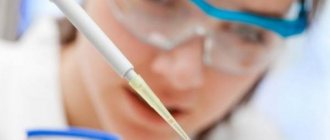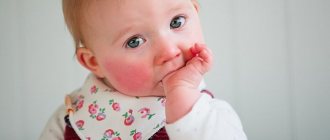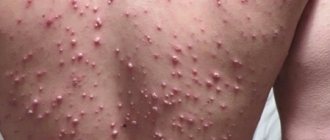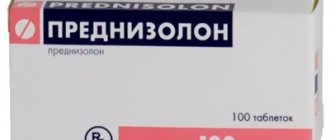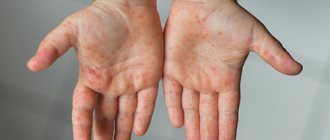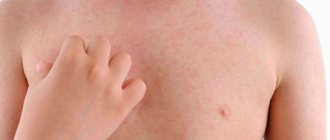How does Komarovsky suggest treating urticaria?
Approximately 15% of children experience urticaria at least once in their lives. Most parents do not know what can cause this disease and how to properly treat it.
The famous Ukrainian doctor Dr. Komarovsky describes in the literature a method of treating the disease.
Komarovsky's technique
The basis of Komarovsky’s technique is data from authoritative scientific journals and recommendations of the World Health Organization. The doctor has a negative attitude towards treatment with homeopathy, drugs with unproven effectiveness, and he is skeptical about traditional medicine.
Urticaria, according to Dr. Komarovsky’s definition, is a rash that manifests itself in the form of blisters on the skin, which have a clear localization and are accompanied by itching.
In some cases, it can appear on the mucous membranes, causing severe swelling. As a rule, the symptoms of urticaria disappear within a few hours after starting treatment.
As a result of certain processes, in particular changes in the capillaries of the skin, a number of substances are released, one of which is histamine. It causes certain reactions, which manifest themselves in the form of urticaria.
What could be the causes of the disease?
If attacks of the disease are single, then most likely they are caused by:
- Food.
- Medicines.
- Viral infection.
This type of urticaria is called acute and its course usually does not last long; most often it goes away without treatment, provided that the provoking factors are eliminated.
As a rule, hives are most often caused by food allergens.
These could be products such as:
- Strawberry.
- Citrus.
- Eggs.
- Seafood.
- Nuts.
- Some types of fish.
To reduce the likelihood of illness, you must first exclude these foods from the child’s diet. Allergic urticaria appears for some time after ingestion of a food product.
This takes from several minutes to hours. It depends on the individual characteristics of the organism. But besides this, medications can also cause such a symptom. For example, such drugs could be:
- Medicines to relieve pain, such as codeine or aspirin.
- Antibiotics of the penicillin or sulfonamide group.
But any drug comes under suspicion, even if it has been used for a long time before and there have been no reactions to it.
Few people know, but physical factors can cause symptoms of urticaria, as well as aggravate its chronic course. These include:
- Sunlight.
- Sweat.
- Cold.
- Pressure.
Why a rash may appear in a child, watch this video:
As a rule, the patient is aware of such factors, since he often notices certain reactions.
Frequent appearance
If the disease occurs almost every day and does not go away for more than 2 months, its chronic course is diagnosed. For most people, the cause of this disease cannot be determined. Physical factors can be aggravating.
The cause of chronic urticaria is rarely found in food, but despite this, foods have the ability to aggravate the disease. One of the main causes of a disease that does not go away for a long time is infection.
This could be, for example, candidiasis. It can also often be caused by emotional stress. In approximately 50% of cases, it resolves spontaneously after six months.
Causes
Flowers are one of the possible causes of the disease
Urticaria is a common disease, but in half of the cases it is impossible to determine the exact cause of its occurrence. Once symptoms occur, a laboratory test must be taken to identify the allergen. Not all parents have this opportunity, so it is enough to know the list of foods and things that can contribute to the occurrence of hives:
- fluff, dust, pollen;
- food: brightly colored vegetables, apples, lemons, oranges, tangerines, dairy products, eggs, nuts, smoked meat and fish, seafood, honey, strawberries, chocolate;
- antibiotics and other drugs: non-steroids, analgesics, etc.
- perfumed cosmetics;
- household chemicals;
- insect bites;
- sweating;
- metal;
- Sun;
- frost, low air temperature.
The appearance of urticaria can be caused by a stressful condition, a weakening of the body's protective properties.
First aid for urticaria in children
First of all, it is necessary to exclude the most dangerous conditions that accompany this symptom: angioedema and anaphylactic shock.
The first condition is accompanied by severe swelling in the larynx, and the second by neurological symptoms, for example, death pangs.
In case of such a manifestation, you must immediately call an ambulance.
If the disease manifests itself only as a local reaction, it is necessary:
- take enterosorbents if urticaria is caused by food allergies.
- Remove the source of poison from an insect bite.
- Remove any irritant, chemical, cosmetic, drug, etc.
After this, you can proceed to prescribing medications.
Treatment
The best treatment is to rule out its cause and avoid it. It is also necessary to protect yourself from factors that aggravate the course of the disease. Once the cause is determined, antihistamines are prescribed to relieve symptoms.
The algorithm for prescribing drugs according to Dr. Komarovsky’s method is as follows. If one method does not help, move on to the next:
- Standard dose of 2nd generation antihistamines.
- Their dose is doubled.
- Adding another 2nd generation drug.
- 1st generation drug.
- Hormonal drugs.
- Immunosuppressants.
However, such treatment is only necessary in rare cases. Usually it is enough just to eliminate the allergen and the symptoms will go away on their own.
How to distinguish urticaria from chickenpox
As we know, chickenpox is caused by a subtype of the herpes virus. In a child, chickenpox appears after contact with a sick person. However, it takes from 14 to 21 days to get sick.
Thus, the mother may not remember whether the child at that time had contact with someone who had chickenpox. The main differences between chickenpox and urticaria are:
- Symptoms of urticaria, in particular rashes, can go away on their own, while the pustules that appear with chickenpox first dry out and then completely fall off.
- Chickenpox rash can be identified by the presence of fluid in the blisters.
- Typically, hives are accompanied by severe itching, whereas chickenpox rashes are not itchy at first.
- If you press on the rash with hives, it disappears.
Also, Dr. Komarovsky constantly reminds that some of the rashes that appear in a child may indicate danger. In particular, such a rash is one of the manifestations of meningitis.
In this case, it resembles bruising and is accompanied by vomiting and fever.
This condition requires immediate medical attention, since the disease is dangerous with a high mortality rate.
This video will tell you what remedies Komarovsky offers for the treatment of urticaria:
According to Dr. Komarovsky, in the presence of any rash, it is also necessary to follow some additional recommendations for organizing the treatment of the child. In particular, the room temperature should be cool and the humidity high.
The doctor also points out that skin diseases can be provoked by too frequent washing using aggressive, antibacterial agents and chlorinated water.
Course of the disease at different ages
Infants and toddlers suffer most from urticaria. This is due to an unformed body and delicate skin. But teenagers are also susceptible to the disease.
This means that when urticaria breaks out in children, Komarovsky offers different treatments. You need to find out the reason first .
- Newborns . Most often, hives are caused by food allergens. It usually goes away quickly. Observation by an allergist is necessary if it turns out that the baby’s urticaria is hereditary.
- Toddler age . The maximum number of diseases occurs between the ages of 1 and 3 years, as children are increasingly in contact with the environment.
- Preschoolers . Allergies to children's toys are added to all the reasons.
- Pupils . In these children, urticaria is sometimes caused by stress and the psychological state of the child, who is getting used to new circumstances and stress.
- Teenagers . Urticaria is observed after sports training with physical activity. It appears half an hour after sweating.
In this video, Dr. Komarovsky will tell you what can cause a rash in children:
What are milia?
If the child's mother suffered from acne of various types, then the likelihood that her child will develop infantile acne remains in 30% of cases. Moreover, they are more common in boys than in girls. Such small formations are localized mainly on the face, covering the cheeks, nose, forehead, and pop up on the chin. Less commonly, they can appear on the neck, back of the head and genitals in boys.
Pimples on the face are white dots called milia or milia. They do not pose a threat to the baby’s condition and, as a rule, go away on their own with proper care.
Diagnosis and treatment are carried out in the following cases:
- find out acne or allergies in a newborn and based on this the question of whether or not to treat is decided;
- if white pimples on the face of a newborn become inflamed.
Nutrition
There is no consensus that a hypoallergenic diet plays an important role in the treatment of urticaria. At one age, a child’s body is not able to perceive a certain product, but at another it reacts to it completely harmlessly for the general state of health.
Of course, dyes, seasonings and preservatives should not be present in the children's diet. Among the foods that cause allergies are nuts, eggs, tomatoes, strawberries, and seafood. If a baby has hives, then the mother needs to monitor her diet.
New foods should be introduced into the diet gradually , at least one per week. A special diary with a menu will help you monitor how your body perceives new foods.
It will be useful for mothers to write down in it both what they themselves ate and the baby’s diet. If urticaria occurs, such recordings will allow you to quickly find out why the baby has a rash on his body.
Important ! When urticaria appears in a child, Dr. Komarovsky knows how to treat it. First of all, don’t get hung up on baby food and blame foods for the rash.
But it is not always the case. There was a case when a mother kept her child on a diet for a long time, but in fact the hives were provoked by sun rays . At the same time, sunscreen, a mandatory Panama hat with a visor, and walks in shaded parks are effective.
Cleaning the apartment plays an important role in the treatment of allergies . It will increase air humidity and rid the room of dust or pollen, which can also provoke the production of histamine and the appearance of skin rashes.
Symptoms
What urticaria looks like in children is of interest to any parent. The main signs will help you quickly recognize the disease and prevent it from developing into a complex or chronic form.
- papules and blisters of various shapes and sizes. They can be located separately or merge with each other;
- the color of the rash ranges from light pink to deep red;
- if you put a little pressure on the rash, a white spot will appear in the center;
- temperature increase. This symptom indicates that an inflammatory process has begun in the body;
- swelling;
- localization of rashes. As a rule, they appear in one place - not the cheeks, arms, legs, stomach, knee bends, etc.
- itching;
- upset stomach, swelling of the face, nausea and vomiting, fever. These are signs of a severe course of the disease.
Photo of hives on a child's legs
The manifestations are similar to other skin rashes - roseola in children, acne, prickly heat, etc. The more detailed you study them, the faster you will decide on the correct diagnosis and further treatment. How quickly does hives go away? In mild cases, within a few hours or days. If there is no treatment, the rash takes longer to resolve. Severe forms of urticaria are more difficult to treat and take longer to treat, since it is necessary to relieve a number of symptoms. Treatment for severe cases may take several weeks.
How to distinguish it from other diseases?
Attentive parents, according to Komarovsky, are quite capable of independently figuring out what exactly has popped up on the baby’s skin—neonatal pimples or allergy rashes. In case of a food or other allergic reaction, the rash will appear on the entire body; in case of newborn acne, the rash will appear only on the face.
And now Dr. Komarovsky himself will tell us what childhood acne is, how this disease is explained and the rules of proper skin care.
An allergic rash, as a rule, gives the child a lot of unpleasant sensations: it itches, itches, the baby begins to behave restlessly, be capricious, and cry for no apparent reason. Newborn acne does not cause any intrusive or unpleasant effects, the child does not feel it.
Acne in babies can be in the form of papules (reddish lumps), comedones (whitish, seemingly “closed” rash) or pustules (reddish lumps with a light top, pus). With an allergic rash, the rashes and the areas around them have a pronounced red tint, without purulent “heads” or whitish tops.
Dr. Komarovsky recommends that when a rash is detected, carefully look at that part of the child’s bottom that is always hidden under the diaper. It does not come into contact with any allergens, and therefore if there is no rash there, then there is no point in talking about food allergies. If it is, then we are most likely not talking about harmless pimples, but a real allergic reaction.
We present to your attention another interesting thematic episode of Dr. Komarovsky’s program.
Sometimes acne is confused with prickly heat. If the baby is wrapped up and daily bathing is neglected, then the rash on the face will actually initially resemble acne (this disease is also called facial discoloration). You can distinguish it by its prevalence - miliaria spreads throughout the body faster than acne, and, as a rule, does not have purulent heads.
Even more often, acne can be confused with dermatitis. Only a doctor can determine the difference, and therefore Komarovsky recommends that in any case, show the baby to a pediatrician.
A few facts about baby rash
- The most dangerous rash is meningococcal, which appears when infected with the microbe meningococcus. Meningitis develops, and systemic blood infection may begin. A child can die within 24 hours, but only on the condition that he is not provided with qualified medical care during this 24-hour period. If parents consult a doctor in time, the probability of avoiding a tragic outcome is close to 90%. Therefore, this combination of symptoms: high fever, vomiting, loss of consciousness and rash is a reason to quickly deliver the child to any nearby medical facility.
- Of the “childhood” diseases, the most dangerous is measles. Chickenpox and rubella are much easier and have fewer complications. Measles is not something to joke about. But if the child is vaccinated, then the disease either does not occur or occurs in a very mild form. Komarovsky recommends not avoiding measles vaccination.
- If a child is covered in a rash, household members and doctors must determine the reasons, excluding one category of relatives, friends and neighbors - pregnant women. Contact with them is strictly prohibited for the child. Any infection is very dangerous for the fetus.
- If the rash itches a lot, then you should suspect skin parasites. Visit a dermatologist and/or infectious disease specialist. Both scabies and fungal infections can be easily and quickly treated if left untreated.
Komarovsky urges parents to understand one simple truth - the causes of the rash are almost never external, but mostly always come from the inside. That is why questions about “what to anoint so that it passes” do not make logical sense. Before being examined by a doctor, there is no need to smear anything with anything, so as not to mislead the doctor. And after the examination, you can apply it if the doctor allows, but the main thing should be to eliminate the internal cause that caused the rash on the skin.
When is a rash on a baby’s face a reason to call a doctor?
In some cases, the appearance of rashes requires contacting a doctor:
- the child is less than six months old;
- the rash is accompanied by fever;
- the rash does not turn pale when pressed;
- after the rash, the baby's skin peels off;
- covered the whole family;
- I suspect this is a reaction to the medications.
Dr. Komarovsky asks you to remember one case when seeking help is required immediately. This is meningococcal meningitis. In rare cases, the pathogen can enter the bloodstream and begin to multiply there. The walls of the blood vessels are damaged, and a small star-shaped rash appears on the skin from internal hemorrhages. When pressed, such pimples do not lighten. This condition is also characterized by an acute onset, high fever, and may include nausea and vomiting. The disease can be treated with antibiotics, but it is important to get to the hospital on time, since it only takes a day from the first symptoms to death. Every ambulance team has the necessary medications, so it is important to report your symptoms by phone when calling the doctors.
Treatment
The success of treating urticaria in children depends on accurate identification of the allergen. Therefore, the first thing doctors recommend is to get tested. After laboratory testing, medications are prescribed. External processing agents:
- "Fenistil";
- "Advantin";
- "Gistan";
- "Elidel"
Doctors do not recommend wiping the rash with products containing alcohol, as they can burn the skin. In difficult cases, injections and oral medications are prescribed. All medications are selected individually by the doctor, depending on the characteristics of the child’s body. In the simplest cases, they resort to folk remedies. Medicinal herbs help relieve itching, improve skin condition, and dry out pustules and blisters.
Recipes for medicinal infusions:
- Pour a handful of dried nettle flowers with 1 tbsp. boiling water, leave for 30 minutes. The infusion should be given to a child with hives in small portions throughout the day.
- Take equal quantities of dried nettle, chamomile, licorice and valerian roots. Grind the herbal mixture, measure out a large spoon, pour 1 tbsp. boiled water, leave for 45 minutes. Let your child drink the infusion in small portions throughout the day.
It is useful to wash the affected areas of the body with an infusion of medicinal herbs: chamomile, calendula, string. The infusion should be at a pleasant room temperature. What should you not do if you have hives? You should not sunbathe or swim in open reservoirs and pools. After the first symptoms appear, give your baby as much water as possible. If you are sure that the rash is a sign of hives, give your child activated charcoal. To prevent your baby from scratching the blisters, trim his nails. In most cases, the cause of itchy rashes is the foods that the baby consumed the day before. Therefore, the children's menu must be carefully analyzed and the necessary adjustments made.
